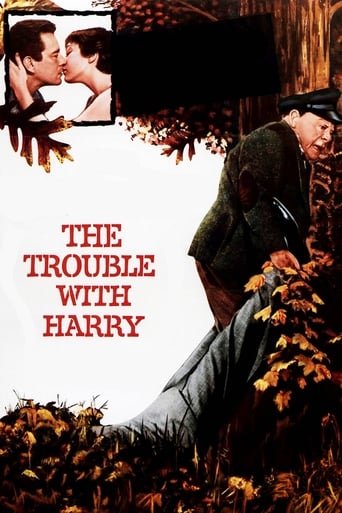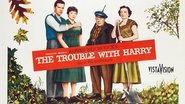HotToastyRag
The real trouble with Harry is that Alfred Hitchcock decided to make a movie about him. Come on, Al, you walked right into that one.I'm not an Alfred Hitchcock fan. Three years of film school taught to revere and appreciate the "master of suspense", but I could never force myself to like his movies. I find them incredibly slow and boring. The Trouble with Harry is no exception. It's very slow, boring, and wordy. There's a dead guy. His name is Harry. Let's spend two hours talking about it.The only reason to watch this movie, besides if you're a Hitchcock fan and actually like his movies, is Shirley MacLaine. This was her first movie; she was plucked from obscurity and made into a star overnight. Well, that's not exactly true. You know that famous story about the understudy who got her big Broadway break when the main actress broke her foot and couldn't go on? That understudy was Shirley MacLaine. Because of her debut onstage in The Pajama Game, she was signed to Paramount Pictures and was subsequently cast in The Trouble with Harry.
JohnHowardReid
NOTES: The film's original reception from both critics and public was lukewarm at best. Although originally advertised as being photographed in VistaVision, this credit has been removed from current (2016) prints. I have a still of Hitch directing a studio interior in which a VistaVision camera is obviously employed, but I must admit my doubts as to such a heavy piece of equipment being dragged all over the beautiful backwoods of Vermont.COMMENT: I enjoyed the film, yes, but it's by no means the height of humorous originality that its fans claim. The idea of a missing, waylaid or bothersome corpse is a standard gimmick in literature. Alec Coppel, in fact, has used this stratagem at least twice: — in his novel, "Mr. Denning Drives North" (filmed in 1951) and in his Broadway stage play, "The Gazebo" (filmed in 1959 with Glenn Ford and Debbie Reynolds). "The Gazebo" has surfaced quite a few times on television, and so has "Mr. Denning..." Both were extremely popular films in their day. So it's no wonder "The Trouble with Harry" was not the super- duper success its makers intended. The total lack of star power didn't help at the time either. (Whilst she has a major role, this was Shirley MacLaine's debut film). On the other hand, the picture is beautifully photographed on wondrously autumnal locations and has so much inherently whimsical and oddball appeal, its visual delights tend to stay in the memory. It's the sort of film that provides such captivating scenery and such mildly memorable characterizations, it can be viewed with pleasure again and again.
lasttimeisaw
Like gold dust, THE TROUBLE WITH HARRY is Hitchcock's fickle dalliance with black comedy, which opens with its spectacular VistaVision variegation of autumn foliage in a Vermont countryside, where a young boy Arnie (Mathers) accidentally finds a man's corpse, later we know his name is Harry and he was not from the village, apparently several residents are involved in the death of Harry.There is Captain Wiles (Gwenn), who believes that he killed Harry with a stray shot from his rifle while he was hunting rabbits, but soon would find all three recipients of his bullets and Harry is not one of them; then the spinster Miss Gravely (Natwick), who claims to kill Harry with the heel of her boot when the latter surprisingly plunges on her from the wood, but why would Harry attack her in the first place? Now, drumroll please, a third key character is Jennifer Rogers (MacLaine), Arnie's mother, she confesses that Harry is her estranged husband, who arrived earlier that day and she hit him with a milk bottle over some divide (nudge nudge wink wink) between them before he headed out towards the wood. So, presumably, a woozy Harry must mistake Miss Gravely for his wife. But is that all the truth about Harry's death, please wait and see.A fourth main character is the local painter Sam Marlowe (Forsythe), when he stumbles upon Harry's body, he draws a portrait of the deceased out of the artistic stimuli, which in due course would trigger the suspicion of Calvin Wiggs (Dano), the Deputy Sheriff. But before that, during the unfolding of the trouble with Harry, Sam and Jennifer become an item, so are Captain Wiles and Miss Gravely, small-town bonhomie does engender romance in a rapid fashion! In fact, the whole film takes place with a full circle of 24-hours, and poor Harry, not only he is afflicted with a weak heart and drop dead in an unfamiliar soil, his body has also been buried and dug out several times and what are all the reasons behind the three-ring circus? As Jennifer blurts out near the end - "I can't remember why".In all fairness, one cannot acknowledge that Hitchcock is a protean filmmaker, certainly comedy doesn't go with his style, despite that the story revolves around a macabre mystery, some red herring is expectedly but uncannily thrown in the face (the closet door in Jennifer's house), however, when the tension and suspense take a back seat, the chummy and cheesy character building and illogical whimsies frustratingly miss the mark.Shirley MacLaine is extraordinarily photogenic in her film debut, but cast a barely 20-year-older as a single mother is something a travesty (she must be married at the age of 13) and John Forsythe is simply anaemic in attempting to heat up the chemistry with her. Yet, it is rather pleasing to see the plot-line around Mildred Natwick and Edmund Gwenn doesn't retreat to the second fiddler when the plot thickens, the quartet remains inseparable through the middle point until the finish line, and certainly the two veterans are more at ease with the tall tale setting and wearing their hearts on their sleeve, so is Mildred Dunnock, who plays Mrs. Wiggs, diligently and dutifully.The film might be simply labeled as a less crowd-pleaser in Hitchcock's oeuvre, but it is the auteur's own favourite, and it also marks the beginning of the renowned Hermann-Hitchcock collaboration, while THE TROUBLE WITH HARRY loses out on the usual Hitchcock-ian trappings, it actually pushes Herrmann's tremendously bewitching work to the foreground, it is lyrical, idyllic and plain optimum.
jc-osms
Hitchcock's only previous attempt at a Hollywood comedy was the unexceptional "Mr and Mrs Smith" in the early 40's and even that came from a studio assignment rather than an original motivation. Here, with the engagement of Hitchcock at the height of his powers, you might guess this one plays a bit differently. Chock-full of (no pun intended) earthy, sometimes racy humour, this is a black comedy set, paradoxically in the beautiful autumnal hues of New England, with a non-starring cast of noticeable variety, from fresh newcomer Shirley MacLaine to the avuncular veteran Edmund Gwenn, not the first names you'd think of to appear in an eccentric piece like this.Also on hand are a pre-"Dynasty" John Forsythe as the reasoning artist Sam and Mildred Natwick as the school-marmy spinster to complete the principal foursome who themselves get into an Abba-type arrangement as they pair off together, thwarted only it would appear by the inconsiderate corpse of MacLaine's unloved, estranged husband which keeps making unwanted appearances to spoil their mutual billing and cooing.I can see how the movie might split Hitchcock's fan-base as there's little of his trademark excitement or tension on show, but that's not to say other of his traits aren't present, from the stunning cinematography of Robert Burks, a playful soundtrack by Bernard Herrman in his first collaboration with The Master and some typically imaginative shots to admire, probably none more so than the first shot of Harry's prostrate body, from the shoes up.The ensemble acting is crisply played and I personally don't get the critics of Miss MacLaine harping on about her gaucheness, as she seems perfectly natural to me in what must have been a rather unusual introduction to movie-making in Hollywood. I admire Hitchcock for taking the risk he did with this off-beat feature and strongly consider he pulled it off with aplomb. A change, after all, is as good as a cardiac arrest as I always say.




